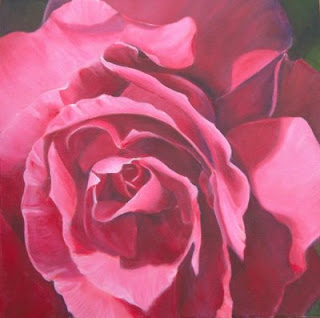
Pink Rose
Acrylic painting
40x40cm on box canvas
40x40cm on box canvas
I painted this rose as part of a monthly challenge on wetcanvas.
The challenge was to paint a rose macro in a colour you found difficult. I always find pinks difficult as they can come out either too sugary, too blue or too red.
The reference is from a rose in my garden. The area where I live, used to be very well known for growing roses for the perfume industry in Grasse. This rose was planted by the previous owners of my property.

Stage 1, Underpainting.
The rose was drawn onto the canvas using watercolour pencil. I then blocked in the darks using cool colours e.g. purple, blues, blue greens and greens, and the lights using warm colors oranges, reds and yellows. I used yellow for where I wanted the lightest highlights.
Paint was added to each area to make the colour look more 'real' I used alazarin crimson for the shadows and permanent rose for the lighter areas, mixed with white to a lesser or greater extent. I used titanium white and some mixing white.
The mixing white makes the colour more transparent, but titanium white gives a better colour, although it is quite opaque. I also mixed the alazarin crimson with ultramarine blue in places.
The paint was added dry, with a scumbling motion. Several layers were used to help get the correct tone.
More pink - permanent rose plus white was added to the light areas. A red layer was also added to the darker areas to give a warmer shadow and then overpainted with alazarin crimson.
To get to stage 4 (the finished piece) I scrumbled a layer of permanent rose all over, before putting on the last coats of pink. The permanent rose layer helped to lessen the 'chalky' look of some of the pink. I also used much thicker paint on the light petals.
Lastly, I used a lot of white in the highlights to give a very light pink and increase the contrast at the focal point.



+%5B640x480%5D.JPG)
+%5B640x480%5D.JPG)
+%5B640x480%5D.JPG)

+%5B640x480%5D.JPG)
+%5B640x480%5D.JPG)
+%5B640x480%5D.JPG)



+%5B640x480%5D.JPG)

